warning lights PORSCHE CAYNNE 2004 1.G Owner's Manual
[x] Cancel search | Manufacturer: PORSCHE, Model Year: 2004, Model line: CAYENNE, Model: PORSCHE CAYENNE 2004 1.GPages: 379, PDF Size: 13.91 MB
Page 123 of 379

Multi-Purpose Display and Instruments
123
Emission ControlThe emission control system detects malfunctions
early that could, for example, cause increased
pollutant emissions or consequential damage.
Faults are indicated by a continuously lit or
flashing instrument panel warning light.
The faults are recorded in the control unit's fault
memory.
The warning light in the instrument panel lights up
when the ignition is switched on as a bulb check
and goes out approx. 4 seconds after the engine
starts. If the warning light does not light up, have
the bulb replaced promptly.The warning light in the instrument panel flashes to
indicate operating states (e.g. engine misfiring)
which might cause damage to certain parts of the
emission control system.
fIn this case, immediately reduce the engine
load by easing off the accelerator.
fIn order to avoid consequential damage to the
engine or emission control system (e.g. cata-
lytic converter), have the fault diagnosed and
rectified immediately at the nearest authorized
Porsche dealer.
If the warning light in the instrument panel lights up
permanently without flashing before and remains
on while driving, it suggests:
– a potential engine control problem and the
need for system service or
– an improperly fastened tank cap or
– the vehicle was refueled while the engine was
running.
fStop immediately at a suitable and secure
place and check tank cap for proper fastening.
If tank cap was fastened correctly, see your
authorized Porsche dealer for service as soon
as possible.
Caution!
If the check engine warning light in the in-
strument panel is flashing, serious catalytic
converter damage and power loss will soon
occur.
Prolonged driving with the check engine
warning light on could cause damage to the
emission control system. It also could affect
fuel economy and driveability.
fHave the fault remedied at the nearest authorized Porsche dealer immediately.
Check engine warning light
10_Cayenne_21_KW17.book Seite 123 Donnerstag, 9. April 2009 3:33 15
Page 134 of 379
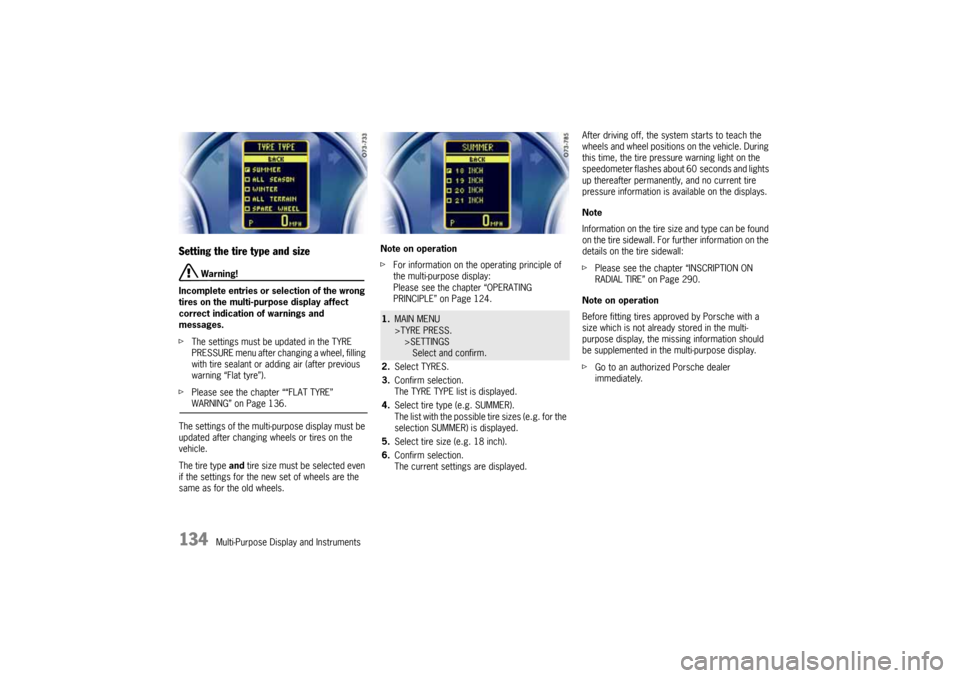
134
Multi-Purpose Display and Instruments
Setting the tire type and size
Warning!
Incomplete entries or selection of the wrong
tires on the multi-purpose display affect
correct indication of warnings and
messages.
fThe settings must be updated in the TYRE
PRESSURE menu after changing a wheel, filling
with tire sealant or adding air (after previous
warning “Flat tyre”).
fPlease see the chapter ““FLAT TYRE” WARNING” on Page 136.
The settings of the multi-purpose display must be
updated after changing wheels or tires on the
vehicle.
The tire type and tire size must be selected even
if the settings for the new set of wheels are the
same as for the old wheels.Note on operation
fFor information on the operating principle of
the multi-purpose display:
Please see the chapter “OPERATING
PRINCIPLE” on Page 124.After driving off, the system starts to teach the
wheels and wheel positions on the vehicle. During
this time, the tire pressure warning light on the
speedometer flashes about 60 seconds and lights
up thereafter permanently, and no current tire
pressure information is available on the displays.
Note
Information on the tire size and type can be found
on the tire sidewall. For further information on the
details on the tire sidewall:
fPlease see the chapter “INSCRIPTION ON
RADIAL TIRE” on Page 290.
Note on operation
Before fitting tires approved by Porsche with a
size which is not already stored in the multi-
purpose display, the missing information should
be supplemented in the multi-purpose display.
fGo to an authorized Porsche dealer
immediately.
1.MAIN MENU
>TYRE PRESS.
>SETTINGS
Select and confirm.
2.Select TYRES.
3.Confirm selection.
The TYRE TYPE list is displayed.
4.Select tire type (e.g. SUMMER).
The list with the possible tire sizes (e.g. for the
selection SUMMER) is displayed.
5.Select tire size (e.g. 18 inch).
6.Confirm selection.
The current settings are displayed.
10_Cayenne_21_KW17.book Seite 134 Donnerstag, 9. April 2009 3:33 15
Page 136 of 379
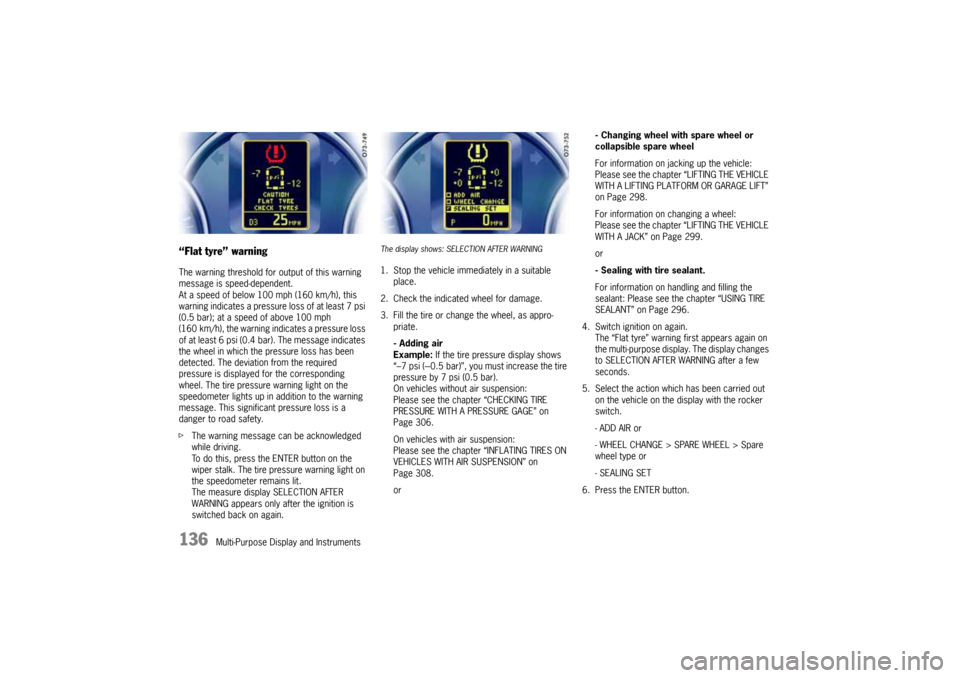
136
Multi-Purpose Display and Instruments
“Flat tyre” warningThe warning threshold for output of this warning
message is speed-dependent.
At a speed of below 100 mph (160 km/h), this
warning indicates a pressure loss of at least 7 psi
(0.5 bar); at a speed of above 100 mph
(160 km/h), the warning indicates a pressure loss
of at least 6 psi (0.4 bar). The message indicates
the wheel in which the pressure loss has been
detected. The deviation from the required
pressure is displayed for the corresponding
wheel. The tire pressure warning light on the
speedometer lights up in addition to the warning
message. This significant pressure loss is a
danger to road safety.
fThe warning message can be acknowledged
while driving.
To do this, press the ENTER button on the
wiper stalk. The tire pressure warning light on
the speedometer remains lit.
The measure display SELECTION AFTER
WARNING appears only after the ignition is
switched back on again.
The display shows: SELECTION AFTER WARNING1. Stop the vehicle immediately in a suitable
place.
2. Check the indicated wheel for damage.
3. Fill the tire or change the wheel, as appro-
priate.
- Adding air
Example: If the tire pressure display shows
“–7 psi (---0.5 bar)”, you must increase the tire
pressure by 7 psi (0.5 bar).
On vehicles without air suspension:
Please see the chapter “CHECKING TIRE
PRESSURE WITH A PRESSURE GAGE” on
Page 306.
On vehicles with air suspension:
Please see the chapter “INFLATING TIRES ON
VEHICLES WITH AIR SUSPENSION” on
Page 308.
or- Changing wheel with spare wheel or
collapsible spare wheel
For information on jacking up the vehicle:
Please see the chapter “LIFTING THE VEHICLE
WITH A LIFTING PLATFORM OR GARAGE LIFT”
on Page 298.
For information on changing a wheel:
Please see the chapter “LIFTING THE VEHICLE
WITH A JACK” on Page 299.
or
- Sealing with tire sealant.
For information on handling and filling the
sealant: Please see the chapter “USING TIRE
SEALANT” on Page 296.
4. Switch ignition on again.
The “Flat tyre” warning first appears again on
the multi-purpose display. The display changes
to SELECTION AFTER WARNING after a few
seconds.
5. Select the action which has been carried out
on the vehicle on the display with the rocker
switch.
- ADD AIR or
- WHEEL CHANGE > SPARE WHEEL > Spare
wheel type or
- SEALING SET
6. Press the ENTER button.
10_Cayenne_21_KW17.book Seite 136 Donnerstag, 9. April 2009 3:33 15
Page 138 of 379
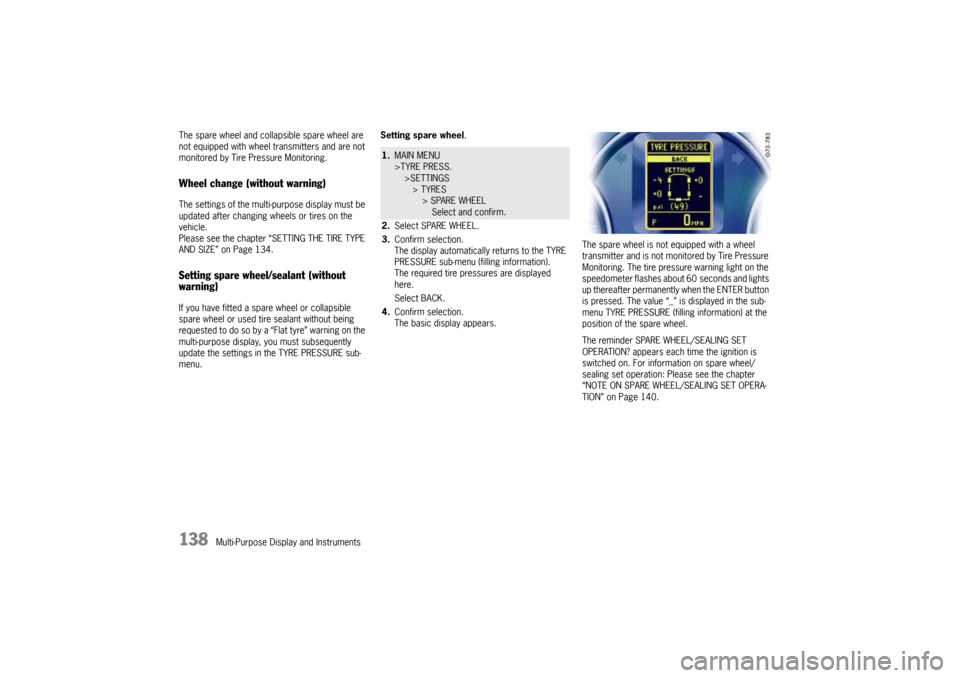
138
Multi-Purpose Display and Instruments The spare wheel and collapsible spare wheel are
not equipped with wheel transmitters and are not
monitored by Tire Pressure Monitoring.
Wheel change (without warning)The settings of the multi-purpose display must be
updated after changing wheels or tires on the
vehicle.
Please see the chapter “SETTING THE TIRE TYPE
AND SIZE” on Page 134.Setting spare wheel/sealant (without
warning)If you have fitted a spare wheel or collapsible
spare wheel or used tire sealant without being
requested to do so by a “Flat tyre” warning on the
multi-purpose display, you must subsequently
update the settings in the TYRE PRESSURE sub-
menu.Setting spare wheel.
The spare wheel is not equipped with a wheel
transmitter and is not monitored by Tire Pressure
Monitoring. The tire pressure warning light on the
speedometer flashes about 60 seconds and lights
up thereafter permanently when the ENTER button
is pressed. The value “_” is displayed in the sub-
menu TYRE PRESSURE (filling information) at the
position of the spare wheel.
The reminder SPARE WHEEL/SEALING SET
OPERATION? appears each time the ignition is
switched on. For information on spare wheel/
sealing set operation: Please see the chapter
“NOTE ON SPARE WHEEL/SEALING SET OPERA-
TION” on Page 140.
1.MAIN MENU
>TYRE PRESS.
>SETTINGS
> TYRES
> SPARE WHEEL
Select and confirm.
2.Select SPARE WHEEL.
3.Confirm selection.
The display automatically returns to the TYRE
PRESSURE sub-menu (filling information).
The required tire pressures are displayed
here.
Select BACK.
4.Confirm selection.
The basic display appears.
10_Cayenne_21_KW17.book Seite 138 Donnerstag, 9. April 2009 3:33 15
Page 139 of 379
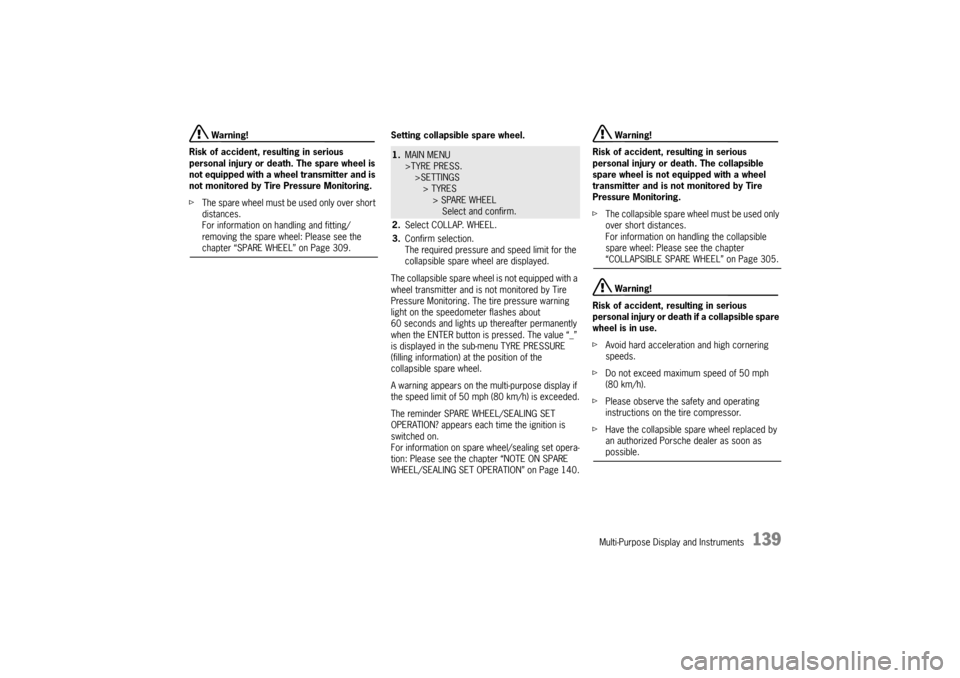
Multi-Purpose Display and Instruments
139
Warning!
Risk of accident, resulting in serious
personal injury or death. The spare wheel is
not equipped with a wheel transmitter and is
not monitored by Tire Pressure Monitoring.
fThe spare wheel must be used only over short
distances.
For information on handling and fitting/
removing the spare wheel: Please see the chapter “SPARE WHEEL” on Page 309.Setting collapsible spare wheel.
The collapsible spare wheel is not equipped with a
wheel transmitter and is not monitored by Tire
Pressure Monitoring. The tire pressure warning
light on the speedometer flashes about
60 seconds and lights up thereafter permanently
when the ENTER button is pressed. The value “_”
is displayed in the sub-menu TYRE PRESSURE
(filling information) at the position of the
collapsible spare wheel.
A warning appears on the multi-purpose display if
the speed limit of 50 mph (80 km/h) is exceeded.
The reminder SPARE WHEEL/SEALING SET
OPERATION? appears each time the ignition is
switched on.
For information on spare wheel/sealing set opera-
tion: Please see the chapter “NOTE ON SPARE
WHEEL/SEALING SET OPERATION” on Page 140.
Warning!
Risk of accident, resulting in serious
personal injury or death. The collapsible
spare wheel is not equipped with a wheel
transmitter and is not monitored by Tire
Pressure Monitoring.
fThe collapsible spare wheel must be used only
over short distances.
For information on handling the collapsible
spare wheel: Please see the chapter “COLLAPSIBLE SPARE WHEEL” on Page 305. Warning!
Risk of accident, resulting in serious
personal injury or death if a collapsible spare
wheel is in use.
fAvoid hard acceleration and high cornering
speeds.
fDo not exceed maximum speed of 50 mph
(80 km/h).
fPlease observe the safety and operating
instructions on the tire compressor.
fHave the collapsible spare wheel replaced by
an authorized Porsche dealer as soon as possible.
1.MAIN MENU
>TYRE PRESS.
>SETTINGS
> TYRES
> SPARE WHEEL
Select and confirm.
2.Select COLLAP. WHEEL.
3.Confirm selection.
The required pressure and speed limit for the
collapsible spare wheel are displayed.
10_Cayenne_21_KW17.book Seite 139 Donnerstag, 9. April 2009 3:33 15
Page 141 of 379
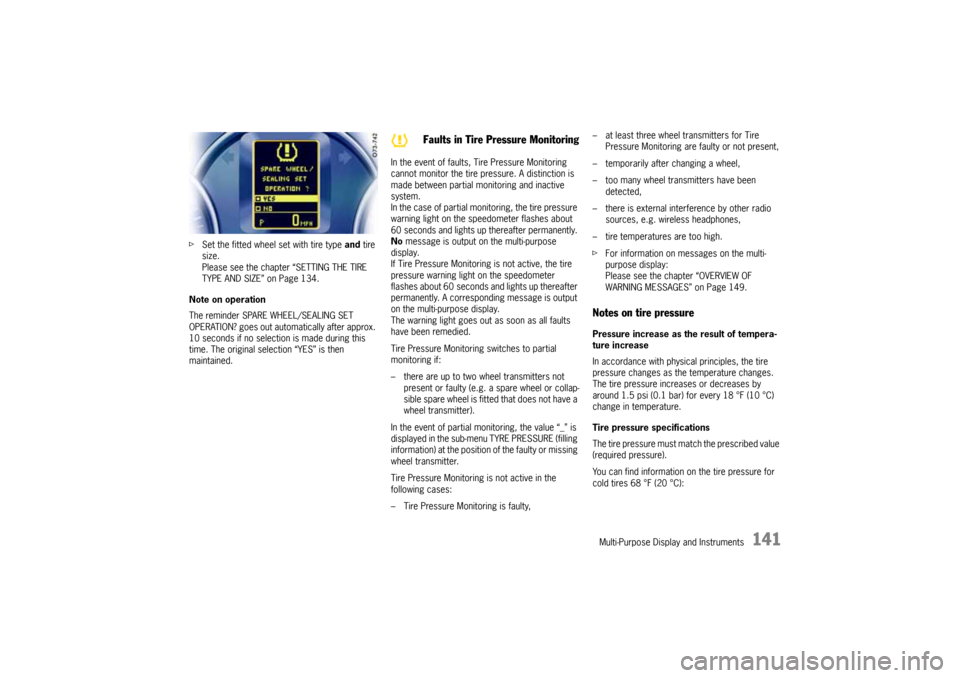
Multi-Purpose Display and Instruments
141
fSet the fitted wheel set with tire type and tire
size.
Please see the chapter “SETTING THE TIRE
TYPE AND SIZE” on Page 134.
Note on operation
The reminder SPARE WHEEL/SEALING SET
OPERATION? goes out automatically after approx.
10 seconds if no selection is made during this
time. The original selection “YES” is then
maintained.In the event of faults, Tire Pressure Monitoring
cannot monitor the tire pressure. A distinction is
made between partial monitoring and inactive
system.
In the case of partial monitoring, the tire pressure
warning light on the speedometer flashes about
60 seconds and lights up thereafter permanently.
No message is output on the multi-purpose
display.
If Tire Pressure Monitoring is not active, the tire
pressure warning light on the speedometer
flashes about 60 seconds and lights up thereafter
permanently. A corresponding message is output
on the multi-purpose display.
The warning light goes out as soon as all faults
have been remedied.
Tire Pressure Monitoring switches to partial
monitoring if:
– there are up to two wheel transmitters not
present or faulty (e.g. a spare wheel or collap-
sible spare wheel is fitted that does not have a
wheel transmitter).
In the event of partial monitoring, the value “_” is
displayed in the sub-menu TYRE PRESSURE (filling
information) at the position of the faulty or missing
wheel transmitter.
Tire Pressure Monitoring is not active in the
following cases:
– Tire Pressure Monitoring is faulty,– at least three wheel transmitters for Tire
Pressure Monitoring are faulty or not present,
– temporarily after changing a wheel,
– too many wheel transmitters have been
detected,
– there is external interference by other radio
sources, e.g. wireless headphones,
– tire temperatures are too high.
fFor information on messages on the multi-
purpose display:
Please see the chapter “OVERVIEW OF
WARNING MESSAGES” on Page 149.
Notes on tire pressurePressure increase as the result of tempera-
ture increase
In accordance with physical principles, the tire
pressure changes as the temperature changes.
The tire pressure increases or decreases by
around 1.5 psi (0.1 bar) for every 18 °F (10 °C)
change in temperature.
Tire pressure specifications
The tire pressure must match the prescribed value
(required pressure).
You can find information on the tire pressure for
cold tires 68 °F (20 °C):
Faults in Tire Pressure Monitoring
10_Cayenne_21_KW17.book Seite 141 Donnerstag, 9. April 2009 3:33 15
Page 150 of 379

150
Multi-Purpose Display and Instruments
Immobilizer active Have the fault remedied at an authorized Porsche dealer.Check left static cornering
lightCheck bulb.Check right static cornering
lightCheck bulb.Check dynamic cornering light Have the fault remedied at an authorized Porsche dealer.
If the warning message appears, the high beam indicator light on the speedometer flashes additionally.Check dipped beam Check bulb.Check trailer lights Check bulb.Check direction indicators Check bulb.Check high beam Check bulb.Check licence plate light Check bulb.Check fog lights Check bulb.Check reversing lights Check bulb.Check front side lights Check bulb.Check headlight beam adjustment Have the fault remedied at an authorized Porsche dealer.Daytime driving lights off Daytime driving lights switch off when the ignition is switched-off.
Switch on lights by light switch if necessary.System fault headlamp Have the fault remedied at an authorized Porsche dealer.
Light on
instrument
panel
Warning message on the multi-purpose
displayMeaning/measures
10_Cayenne_21_KW17.book Seite 150 Donnerstag, 9. April 2009 3:33 15
Page 159 of 379
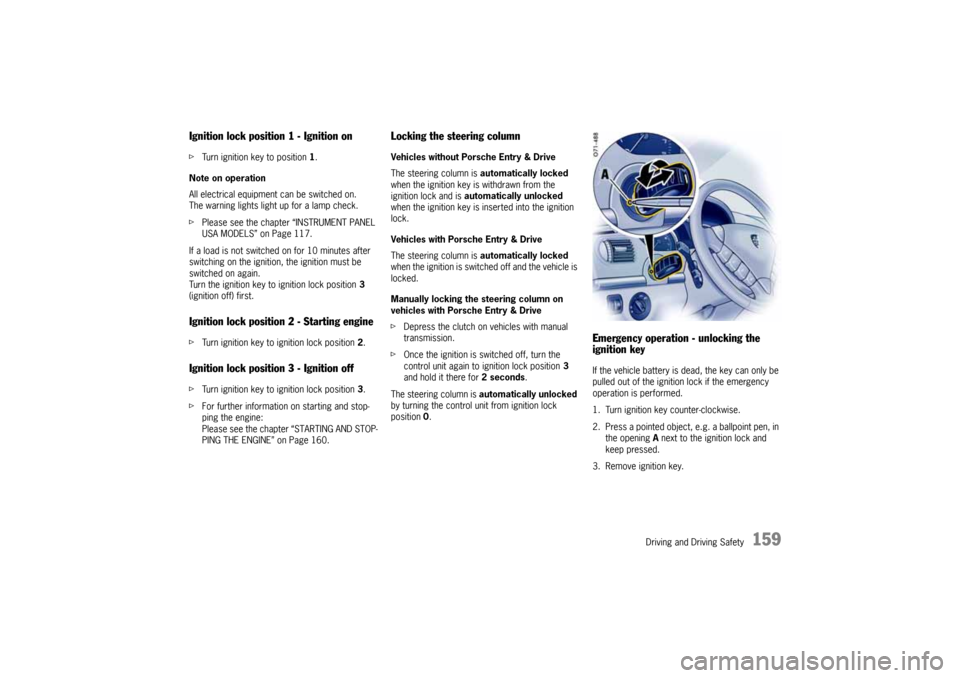
Driving and Driving Safety
159
Ignition lock position 1 - Ignition onfTurn ignition key to position 1.
Note on operation
All electrical equipment can be switched on.
The warning lights light up for a lamp check.
fPlease see the chapter “INSTRUMENT PANEL
USA MODELS” on Page 117.
If a load is not switched on for 10 minutes after
switching on the ignition, the ignition must be
switched on again.
Turn the ignition key to ignition lock position 3
(ignition off) first.Ignition lock position 2 - Starting enginefTurn ignition key to ignition lock position 2.Ignition lock position 3 - Ignition offfTurn ignition key to ignition lock position 3.
fFor further information on starting and stop-
ping the engine:
Please see the chapter “STARTING AND STOP-
PING THE ENGINE” on Page 160.
Locking the steering column Vehicles without Porsche Entry & Drive
The steering column is automatically locked
when the ignition key is withdrawn from the
ignition lock and is automatically unlocked
when the ignition key is inserted into the ignition
lock.
Vehicles with Porsche Entry & Drive
The steering column is automatically locked
when the ignition is switched off and the vehicle is
locked.
Manually locking the steering column on
vehicles with Porsche Entry & Drive
fDepress the clutch on vehicles with manual
transmission.
fOnce the ignition is switched off, turn the
control unit again to ignition lock position 3
and hold it there for 2seconds.
The steering column is automatically unlocked
by turning the control unit from ignition lock
position 0.
Emergency operation - unlocking the
ignition keyIf the vehicle battery is dead, the key can only be
pulled out of the ignition lock if the emergency
operation is performed.
1. Turn ignition key counter-clockwise.
2. Press a pointed object, e.g. a ballpoint pen, in
the opening A next to the ignition lock and
keep pressed.
3. Remove ignition key.
10_Cayenne_21_KW17.book Seite 159 Donnerstag, 9. April 2009 3:33 15
Page 160 of 379

160
Driving and Driving Safety
Starting and Stopping the EnginefPlease see the chapter “IMMOBILIZER” on
Page 248.
fPlease see the chapter “EMISSION CONTROL
SYSTEM” on Page 263.
Danger!
Risk of poisoning. Exhaust gas contains
colorless and odorless carbon monoxide
(CO), which is toxic even in low concentra-
tion. Carbon monoxide can cause uncon-
sciousness and even death if inhaled.
fNever start or let the engine run in an en-
closed, unventilated area. It is not recommen-
ded to sit in your car for prolonged periods
with the engine on and the car not moving.
An unattended vehicle with a running engine
is potentially hazardous. If warning lights
should come on to indicate improper opera-
tion, they would go unnoticed.
fNever leave the engine idling unattended.
Danger of fire.
fDo not drive or park your car where combus-
tible materials, such as dry grass or leaves,
can come into contact with the hot exhaust
system.
fIf your car catches on fire for any reason, call
the fire department. Do not endanger your life by attempting to put out the fire.
Starting vehiclefOperate footbrake.
fFully depress and hold the clutch pedal. Put the
gearshift lever in neutral or on vehicles with
Tiptronic S:
move the Tiptronic selector lever to position P
or N.
fDo not press the accelerator pedal. The engine
control module will provide the correct starting
mixture.
fTurn ignition key to ignition lock position 2.
fDo not operate the starter longer than approx.
10 seconds. If necessary, repeat the starting
procedure after a pause of approx.
10 seconds. Turn the ignition key back to
ignition lock position 3 first.
Notes on operation
The first operation of the starter is ended auto-
matically when the engine starts.
If the engine does not start, subsequent starter
operations will not be ended automatically.
When the engine ist started, the warning lights
must go out.fDo not warm up the engine when stationary.
Drive off immediately.
Avoid high revolutions and full throttle until the
engine has reached operating temperature.
fIf battery output is insufficient, jump leads can
be used to start the engine.
Please see the chapter “EMERGENCY
STARTING WITH JUMPER CABLES” on
Page 323.
Note on operation
To ensure a good charge condition for the battery
and thus its ability to start the engine, all electrical
accessories which are not required should be
switched off when the ignition is switched on and
when engine revolutions are low (in stop and go
traffic).
10_Cayenne_21_KW17.book Seite 160 Donnerstag, 9. April 2009 3:33 15
Page 162 of 379
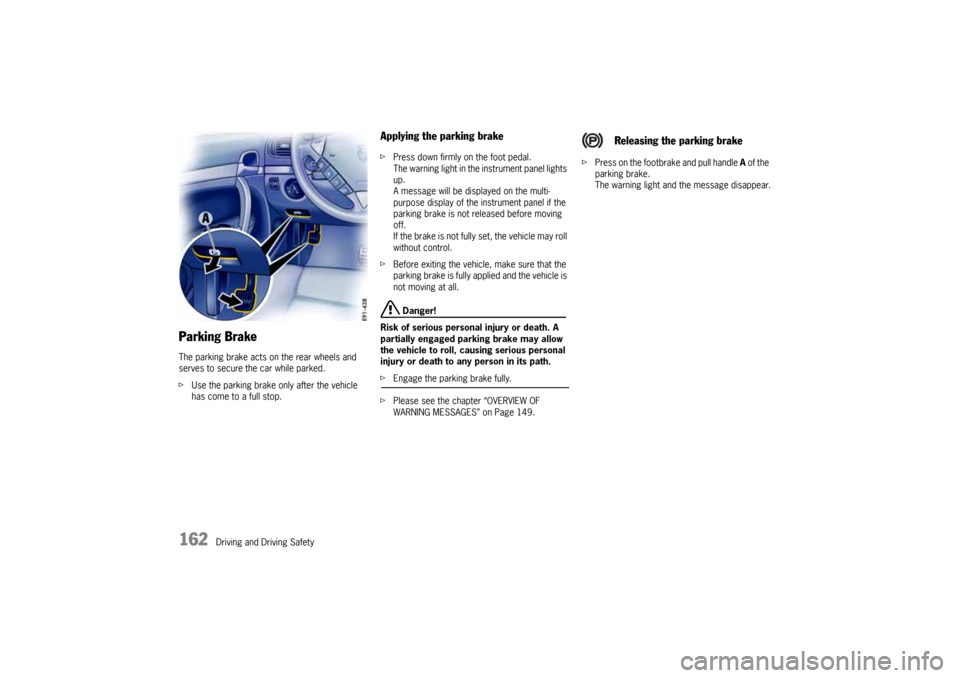
162
Driving and Driving Safety
Parking BrakeThe parking brake acts on the rear wheels and
serves to secure the car while parked.
fUse the parking brake only after the vehicle
has come to a full stop.
Applying the parking brakefPress down firmly on the foot pedal.
The warning light in the instrument panel lights
up.
A message will be displayed on the multi-
purpose display of the instrument panel if the
parking brake is not released before moving
off.
If the brake is not fully set, the vehicle may roll
without control.
fBefore exiting the vehicle, make sure that the
parking brake is fully applied and the vehicle is
not moving at all.
Danger!
Risk of serious personal injury or death. A
partially engaged parking brake may allow
the vehicle to roll, causing serious personal
injury or death to any person in its path.
fEngage the parking brake fully.
fPlease see the chapter “OVERVIEW OF
WARNING MESSAGES” on Page 149.fPress on the footbrake and pull handle A of the
parking brake.
The warning light and the message disappear.
Releasing the parking brake
10_Cayenne_21_KW17.book Seite 162 Donnerstag, 9. April 2009 3:33 15